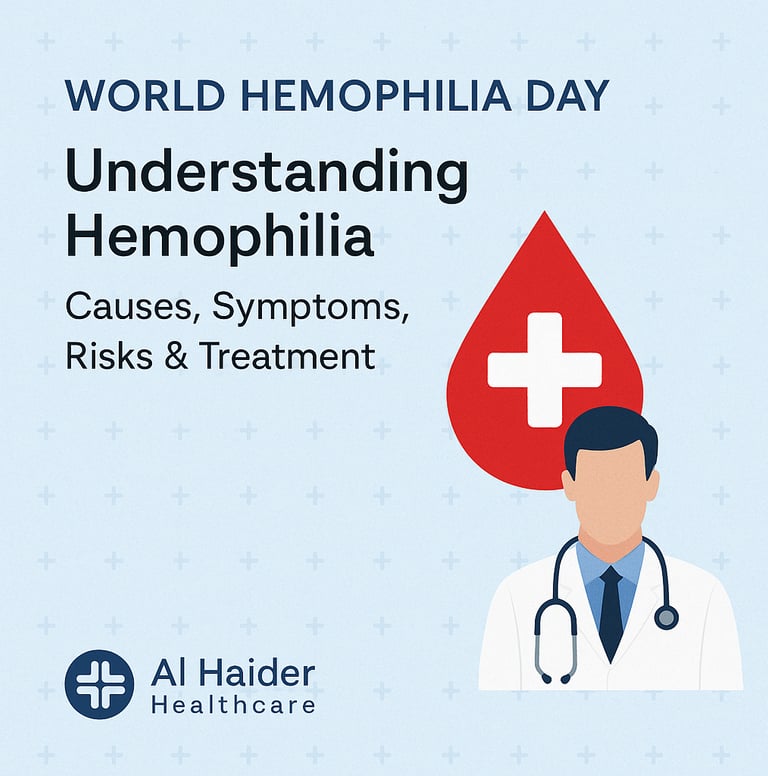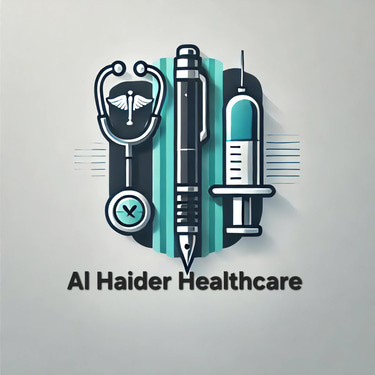

🩸 World Hemophilia Day: Understanding Hemophilia – Causes, Symptoms, Risks & Treatment
Published by Al Haider Healthcare (ahchospital.in) | April 17 | #WorldHemophiliaDay
Every year on April 17, the world observes World Hemophilia Day to raise awareness about hemophilia and other inherited bleeding disorders. This day also commemorates the birth of Frank Schnabel, founder of the World Federation of Hemophilia (WFH). At Al Haider Healthcare, we aim to spread awareness, support early diagnosis, and promote better access to care for patients affected by hemophilia.
🔬 What is Hemophilia?
Hemophilia is a rare genetic bleeding disorder where the blood does not clot properly due to the absence or low levels of specific clotting factors. People with hemophilia bleed longer after an injury and may also experience spontaneous internal bleeding, especially in the joints and muscles.
⚠️ Symptoms of Hemophilia
Symptoms can vary depending on the severity of the condition:
Common signs include:
Prolonged bleeding after cuts, injuries, or surgery
Frequent nosebleeds
Easy bruising
Swollen, painful joints due to internal bleeding (hemarthrosis)
Blood in urine or stool
In infants, unexplained irritability and swelling from bleeding into muscles
📊 Risk Factors
The primary risk factors for hemophilia include:
Family history: Having a parent or sibling with hemophilia greatly increases the risk.
Gender: Since it is X-linked, males are most commonly affected.
Carriers: Females can carry the gene and pass it to children. In rare cases, they may show mild symptoms too.
🔗 Source: World Health Organization (WHO)
🩺 Diagnosis
Hemophilia is diagnosed through:
Clotting factor tests (factor assays)
Complete blood count (CBC)
Activated partial thromboplastin time (aPTT)
Genetic testing (to identify carrier status)
Early diagnosis helps in better management and prevention of complications.
💉 Treatment of Hemophilia
The primary treatment is replacement therapy, which involves:
Infusing missing clotting factors (Factor VIII or IX) intravenously.
These can be plasma-derived or recombinant (synthetic).
Other treatments include:
Desmopressin (DDAVP): For mild Hemophilia A, stimulates release of stored Factor VIII.
Antifibrinolytics: Prevent clot breakdown.
Gene therapy: A promising long-term solution under development.
Preventive (prophylactic) therapy: Regular infusions to prevent bleeding episodes.
👶 Hemophilia in Children
Children with hemophilia need special care:
Avoid rough play and contact sports.
Use soft toothbrushes to prevent gum bleeding.
Immunizations should be given subcutaneously instead of intramuscularly.
Early physiotherapy can prevent joint deformities.
🧠 Living with Hemophilia
With proper care and treatment, people with hemophilia can live long, healthy lives. Key lifestyle tips include:
Regular follow-ups with a hematologist
Safe exercise (e.g., swimming, walking)
Healthy, balanced diet to maintain joint and muscle health
Awareness of bleeding signs and emergency care
🌍 Global Perspective and India's Situation
According to the World Federation of Hemophilia, over 400,000 people globally are affected by hemophilia, but only 25% receive adequate treatment.
In India, thousands of cases remain undiagnosed or untreated, especially in rural areas. Awareness campaigns and affordable access to clotting factors are crucial for saving lives.
🔗 Source: World Federation of Hemophilia (WFH)
🤝 Al Haider Healthcare’s Message on World Hemophilia Day
This World Hemophilia Day, we pledge to: ✅ Raise awareness
✅ Promote early diagnosis
✅ Support local and national hemophilia care initiatives
✅ Educate patients and families on self-care and treatment
Let us join hands to build a world where every person with a bleeding disorder has access to proper care and treatment.
📞 Need Help?
If you or a loved one is showing signs of bleeding disorders, visit Al Haider Healthcare, Sathi, West Champaran for consultation and guidance.
📍 Website: www.ahchospital.in
📧 Email: alhaiderhealthcare@gmail.com
#WorldHemophiliaDay | #HemophiliaAwareness | #AlHaiderHealthcare | #AHCHospital | #BleedingDisorders | #BloodHealth
There are two main types:
Hemophilia A: Caused by a deficiency in Factor VIII.
Hemophilia B: Caused by a deficiency in Factor IX.
Both types are inherited in an X-linked recessive pattern, meaning it primarily affects males, while females can be carriers.
